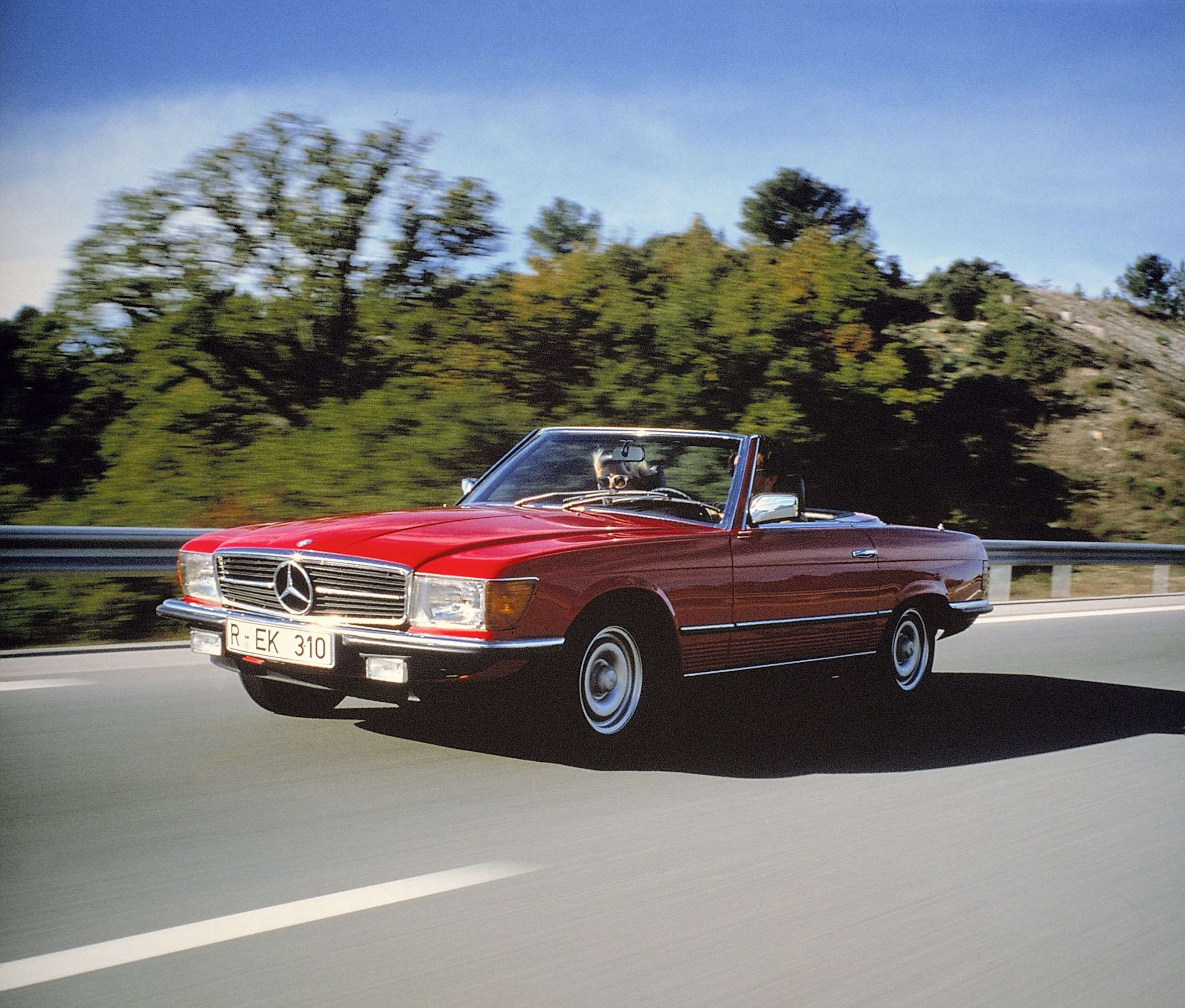The Mercedes-benz R107, a two-seater roadster launched half a century ago, might not have initially ignited everyone’s passion, but its enduring presence on the roads speaks volumes about its lasting appeal. While some may have initially overlooked this Stuttgart creation as just another posh and heavy convertible, a recent experience highlighted the R107’s undeniable popularity and legacy. Caught in Friday afternoon traffic en route from Goodwood, a surprising number of gleaming R107 SLs, driven by mature enthusiasts, suggested a silent celebration of this Teutonic model’s 50th anniversary was underway. This unexpected encounter prompted a deeper look into the Mercedes-Benz R107 and its significance in automotive history.
From Pagoda to Pillarless: The R107’s Place in SL History
Succeeding the iconic Paul Bracq-designed W113 “Pagoda” SL (1963-71) was no easy task. The Pagoda, with its distinctive dished hardtop, had captivated the swinging sixties. However, Mercedes-Benz masterfully transitioned to the R107 series SL in 1971, a model that would enjoy an impressive 18-year production run until 1989. The R107 paved the way for the more dynamically styled R129 SL (1989-2001), proving its staying power as a stylish, solidly engineered, and commercially successful “sporting” Mercedes-Benz. Over its lifespan, more than 237,000 R107 SL roadsters were built, alongside an additional 63,000 SLC C107 coupes, the latter being a long-wheelbase 2+2 variant based on the R107 platform.
The Mercedes-Benz R107 and its SLC coupe sibling (introduced in 1972 and produced until 1981) were immediate hits, attracting a substantial order book right from the start. Interestingly, the R107’s visual design remained remarkably consistent throughout its long production run. From its horizontal headlights and prominent chrome grille to its fluted taillights – a Mercedes innovation designed to stay clean in all weather conditions and later adopted by the W116 S-Class and subsequent models – the styling was undeniably conservative, perhaps not setting hearts ablaze, but certainly inoffensive and broadly appealing.
Engine Evolution: Powering the R107 Across Markets
While the exterior aesthetics of the Mercedes-Benz R107 remained largely unchanged, its engine lineup underwent significant evolution over its 18 years. Initially launched exclusively as the 350SL with a 200PS (141kW) straight-six engine, the range quickly expanded. An entry-level 280SL variant, producing 190PS (140kW), was introduced, and at the top end, the North American market, which absorbed the majority of R107 production, received the powerful 560SL, boasting a 230PS (169kW) V8 engine. This range of engines ensured the R107 catered to different preferences and market demands, contributing to its global success.
The Mercedes-Benz R107 became a favorite among affluent members of golf clubs and the jet set worldwide. Its popularity transcended demographics, finding its way into Hollywood movies and television shows. Notably, Bobby Ewing from the iconic 1980s soap opera Dallas famously drove an R107, albeit one adapted for the North American market with large, less aesthetically pleasing federal bumpers and quad round headlamps. Despite not being universally lauded as beautiful as its W113 predecessor, perhaps due to its short wheelbase and long overhangs, the R107’s understated yet safe styling resonated with buyers from day one.
A Boulevard Cruiser in a World of Sporting Rivals
When the Mercedes-Benz R107 debuted in 1971, it entered a market filled with compelling and diverse sporting executive cars. Competitors like the graceful Fiat 130 Coupe, the technically advanced Citroën SM, the muscular Alfa Romeo Montreal, and the potent V12 Jaguar E-type Series 3 all emerged in the same year. In this context, the R107, while undeniably safe and well-built, could be perceived as a less adventurous and more conservative choice. It arguably lacked the outright verve, stylistic flair, and pure driving excitement of some of its contemporaries. Yet, the R107 outlived and arguably outlasted many of these rivals, testament to its inherent strengths and market appeal.
Later in its life cycle, new contenders aimed directly at the R107’s “boulevard cruiser” niche. The Jaguar XJ-S and the Cadillac Allante, while attempting to challenge the SL’s dominance, never managed to significantly impact the consistent and unwavering demand for this “play it safe” Mercedes-Benz roadster. This enduring popularity underscores the R107’s ability to consistently deliver on its promise of refined open-top motoring.
From Super Light to Solidly Built: The SL Evolution
The Mercedes-Benz R107 represented the third generation of the legendary SL lineage, tracing its roots back to the original 1952 competition-focused 300 SL (with “SL” purportedly standing for Super Leicht, or “super light” in German). However, by the time the R107 arrived in 1971, the term “super light” was no longer applicable. The two-seater R107 tipped the scales at a considerable 1,500kg-plus, reflecting a shift towards a more substantial and luxurious grand touring experience.
The first production Mercedes SL, the iconic 300SL “Gullwing” W198 coupe of 1954, remains arguably the most celebrated and sought-after SL model. This legendary coupe spawned the more accessible W121 190SL roadster in 1957, a heavier, conventionally-doored cruiser that preceded the elegant W113 in 1963, ultimately leading to the long and successful production run of the R107 half a century ago.
The R107 Legacy and the Future of SL
The recent launch of the latest Mercedes-AMG SL brings the SL story into the modern era. AMG’s involvement promises to inject renewed sporting credentials into the model, aiming to create a true driver’s car, a departure perhaps from the more relaxed grand touring ethos of the R107. While the R107 might be characterized as more suited for leisurely drives to the golf club or hair salon than for spirited, engaging driving experiences, its enduring appeal is undeniable. It represents a significant chapter in the Mercedes-Benz SL narrative, bridging the gap between the early, more overtly sporting models and the modern AMG-enhanced iterations. The hope is that the new generation SL will capture the engaging driving dynamics that some felt were missing in the R107, while retaining the luxury and timeless appeal that has always defined the Mercedes-Benz SL.
